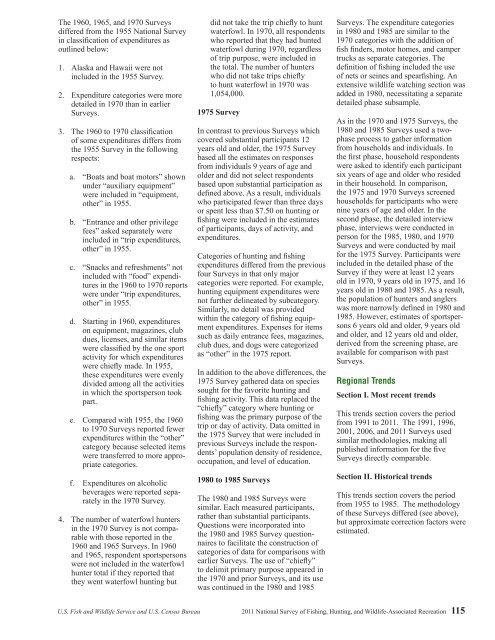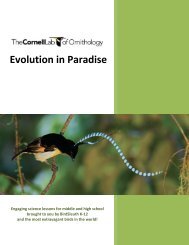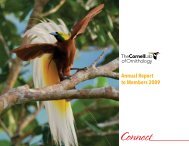household income in the 2001<strong>Survey</strong>.6. A question was added to the triprelatedexpenditures section toascertain how much <strong>of</strong> the totalwas spent in the respondent’s state<strong>of</strong> residence when the respondentparticipated in hunting, fishing, orwildlife watching out-<strong>of</strong>-state.7. Boating questions were added tothe fishing section. The respondentwas asked about the extent <strong>of</strong> boatusage for the three types <strong>of</strong> fishing.8. The 1996 <strong>Survey</strong> included questionsabout the months around-thehomewildlife watchers fed birds.These questions were not repeatedin the 2001 <strong>Survey</strong>.9. The contingent valuation sections<strong>of</strong> the three types <strong>of</strong> wildlife-relatedrecreation were altered, using anopen-ended question format instead<strong>of</strong> 1996’s dichotomous choiceformat.Section III. Important instrumentchanges in the 2006 <strong>Survey</strong>1. A series <strong>of</strong> boating questions wasadded. The new questions dealtwith anglers using motorboats <strong>and</strong>/or nonmotorboats, length <strong>of</strong> boatused most <strong>of</strong>ten, distance to boatlaunch used most <strong>of</strong>ten, neededimprovements to facilities at thelaunch, whether or not the respondentcompleted a boating safetycourse, who the boater fished withmost <strong>of</strong>ten, <strong>and</strong> the source <strong>and</strong> type<strong>of</strong> information the boater used forhis or her fishing.2. Questions regarding catch <strong>and</strong>release fishing were added. Theywere whether or not the respondentcaught <strong>and</strong> released fish <strong>and</strong>, if so,the percent <strong>of</strong> fish released.3. The proportion <strong>of</strong> huntingdone with a rifle or shotgun, ascontrasted with muzzleloader orarchery equipment, was asked.4. In the contingent valuation section,where the value <strong>of</strong> wildlife-relatedrecreation was determined, twoquality-variable questions wereadded: the average length <strong>of</strong> certainfish caught <strong>and</strong> whether a deer,elk, or moose was killed. Plus theeconomic evaluation bid questionswere rephrased, from “What isthe most your [species] hunting in[State name] could have cost youper trip last year before you wouldNOT have gone [species] huntingat all in 2001, not even one trip,because it would have been tooexpensive?”, for the hunters, forexample, to “What is the cost thatwould have prevented you fromtaking even one such trip in 2006?In other words, if the trip cost wasbelow this amount, you would havegone [species] hunting in [Statename], but if the trip cost wasabove this amount, you would nothave gone.”5. Questions concerning hunting,fishing, or wildlife watching inother countries were taken out <strong>of</strong>the <strong>Survey</strong>.6. Questions about the reasons fornot going hunting or fishing, or notgoing as much as expected, weredeleted.7. Disability <strong>of</strong> participants questionswere taken out.8. Determination <strong>of</strong> the types <strong>of</strong>sites for wildlife watching wasdiscontinued.9. The birding questions regardingthe use <strong>of</strong> birding life lists <strong>and</strong> theability to identify birds based ontheir sight or sounds were deleted.10. Public transportation costs weredivided into two sections, “publictransportation by airplane” <strong>and</strong>“other public transportation,including trains, buses, <strong>and</strong> carrentals, etc.”.Section IV. Important instrumentchanges in the 2011 <strong>Survey</strong>1. The series <strong>of</strong> boating questionsadded in 2006 was deleted.2. Questions about target shooting <strong>and</strong>the usage <strong>of</strong> a shooting range inpreparation for hunting were added.The types <strong>of</strong> weapon used at theshooting range were quantified.3. Questions about plantings expendituresfor the purpose <strong>of</strong> huntingwere added.4. “Feral pig” was recategorized frombig game to other animals for allstates except Hawaii.5. “Ptarmigan” was included as itsown small game category, instead<strong>of</strong> lumped in “other.”6. In previous <strong>Survey</strong>s, “Moose” wasincluded as its own category onlyfor Alaska. For 2011, “Moose”was included as its own big gamecategory, instead <strong>of</strong> lumped in“other,” for all fifty states.7. In previous <strong>Survey</strong>s, “Wolf” wasincluded as its own category onlyfor Alaska. For 2011, “Wolf” wasincluded as its own other animalcategory, instead <strong>of</strong> lumped in“other,” for all fifty states.8. The household income categorieswere modified. The top categorieswere changed from “$100,000 ormore” to “$100,000 to $149,999”<strong>and</strong> “$150,000 or more.”9. The “Steelhead” category wasdeleted from the saltwater fishspecies section, with the idea that itwould be included in “other.”10. The 2006 around-the-homewildlife-watching category thatquantified visitors <strong>of</strong> ”public parksor areas” was rewritten to wildlifewatching at “parks or naturalareas.” This change was to makeclear that respondents shouldinclude recreating at quasi-governmental<strong>and</strong> private areas.11. The 2006 wildlife watching equipmentcategory “Film <strong>and</strong> developing”was rewritten to “Film <strong>and</strong>photo processing.”1955 to 1985 SignificantMethodological Differences1955 to 1970 <strong>Survey</strong>sThe 1955 to 1970 <strong>Survey</strong>s includedonly substantial participants. Substantialparticipants were defined as peoplewho participated at least three days<strong>and</strong>/or spent at least $5 (the 1955–1965<strong>Survey</strong>s) or $7.50 (the 1970 <strong>Survey</strong>)during the surveyed year. Under mostcircumstances, the <strong>Survey</strong>s may becompared for totals, but the effects <strong>of</strong>differences should be considered whencomparing the details <strong>of</strong> the <strong>Survey</strong>s.114 2011 <strong>National</strong> <strong>Survey</strong> <strong>of</strong> <strong>Fishing</strong>, <strong>Hunting</strong>, <strong>and</strong> <strong>Wildlife</strong>-Associated Recreation U.S. Fish <strong>and</strong> <strong>Wildlife</strong> Service <strong>and</strong> U.S. Census Bureau
The 1960, 1965, <strong>and</strong> 1970 <strong>Survey</strong>sdiffered from the 1955 <strong>National</strong> <strong>Survey</strong>in classification <strong>of</strong> expenditures asoutlined below:1. Alaska <strong>and</strong> Hawaii were notincluded in the 1955 <strong>Survey</strong>.2. Expenditure categories were moredetailed in 1970 than in earlier<strong>Survey</strong>s.3. The 1960 to 1970 classification<strong>of</strong> some expenditures differs fromthe 1955 <strong>Survey</strong> in the followingrespects:a. “Boats <strong>and</strong> boat motors” shownunder “auxiliary equipment”were included in “equipment,other” in 1955.b. “Entrance <strong>and</strong> other privilegefees” asked separately wereincluded in “trip expenditures,other” in 1955.c. “Snacks <strong>and</strong> refreshments” notincluded with “food” expendituresin the 1960 to 1970 reportswere under “trip expenditures,other” in 1955.d. Starting in 1960, expenditureson equipment, magazines, clubdues, licenses, <strong>and</strong> similar itemswere classified by the one sportactivity for which expenditureswere chiefly made. In 1955,these expenditures were evenlydivided among all the activitiesin which the sportsperson tookpart.e. Compared with 1955, the 1960to 1970 <strong>Survey</strong>s reported fewerexpenditures within the “other”category because selected itemswere transferred to more appropriatecategories.f. Expenditures on alcoholicbeverages were reported separatelyin the 1970 <strong>Survey</strong>.4. The number <strong>of</strong> waterfowl huntersin the 1970 <strong>Survey</strong> is not comparablewith those reported in the1960 <strong>and</strong> 1965 <strong>Survey</strong>s. In 1960<strong>and</strong> 1965, respondent sportspersonswere not included in the waterfowlhunter total if they reported thatthey went waterfowl hunting butdid not take the trip chiefly to huntwaterfowl. In 1970, all respondentswho reported that they had huntedwaterfowl during 1970, regardless<strong>of</strong> trip purpose, were included inthe total. The number <strong>of</strong> hunterswho did not take trips chieflyto hunt waterfowl in 1970 was1,054,000.1975 <strong>Survey</strong>In contrast to previous <strong>Survey</strong>s whichcovered substantial participants 12years old <strong>and</strong> older, the 1975 <strong>Survey</strong>based all the estimates on responsesfrom individuals 9 years <strong>of</strong> age <strong>and</strong>older <strong>and</strong> did not select respondentsbased upon substantial participation asdefined above. As a result, individualswho participated fewer than three daysor spent less than $7.50 on hunting orfishing were included in the estimates<strong>of</strong> participants, days <strong>of</strong> activity, <strong>and</strong>expenditures.Categories <strong>of</strong> hunting <strong>and</strong> fishingexpenditures differed from the previousfour <strong>Survey</strong>s in that only majorcategories were reported. For example,hunting equipment expenditures werenot further delineated by subcategory.Similarly, no detail was providedwithin the category <strong>of</strong> fishing equipmentexpenditures. Expenses for itemssuch as daily entrance fees, magazines,club dues, <strong>and</strong> dogs were categorizedas “other” in the 1975 report.In addition to the above differences, the1975 <strong>Survey</strong> gathered data on speciessought for the favorite hunting <strong>and</strong>fishing activity. This data replaced the“chiefly” category where hunting orfishing was the primary purpose <strong>of</strong> thetrip or day <strong>of</strong> activity. Data omitted inthe 1975 <strong>Survey</strong> that were included inprevious <strong>Survey</strong>s include the respondents’population density <strong>of</strong> residence,occupation, <strong>and</strong> level <strong>of</strong> education.1980 to 1985 <strong>Survey</strong>sThe 1980 <strong>and</strong> 1985 <strong>Survey</strong>s weresimilar. Each measured participants,rather than substantial participants.Questions were incorporated intothe 1980 <strong>and</strong> 1985 <strong>Survey</strong> questionnairesto facilitate the construction <strong>of</strong>categories <strong>of</strong> data for comparisons withearlier <strong>Survey</strong>s. The use <strong>of</strong> “chiefly”to delimit primary purpose appeared inthe 1970 <strong>and</strong> prior <strong>Survey</strong>s, <strong>and</strong> its usewas continued in the 1980 <strong>and</strong> 1985<strong>Survey</strong>s. The expenditure categoriesin 1980 <strong>and</strong> 1985 are similar to the1970 categories with the addition <strong>of</strong>fish finders, motor homes, <strong>and</strong> campertrucks as separate categories. Thedefinition <strong>of</strong> fishing included the use<strong>of</strong> nets or seines <strong>and</strong> spearfishing. Anextensive wildlife watching section wasadded in 1980, necessitating a separatedetailed phase subsample.As in the 1970 <strong>and</strong> 1975 <strong>Survey</strong>s, the1980 <strong>and</strong> 1985 <strong>Survey</strong>s used a twophaseprocess to gather informationfrom households <strong>and</strong> individuals. Inthe first phase, household respondentswere asked to identify each participantsix years <strong>of</strong> age <strong>and</strong> older who residedin their household. In comparison,the 1975 <strong>and</strong> 1970 <strong>Survey</strong>s screenedhouseholds for participants who werenine years <strong>of</strong> age <strong>and</strong> older. In thesecond phase, the detailed interviewphase, interviews were conducted inperson for the 1985, 1980, <strong>and</strong> 1970<strong>Survey</strong>s <strong>and</strong> were conducted by mailfor the 1975 <strong>Survey</strong>. Participants wereincluded in the detailed phase <strong>of</strong> the<strong>Survey</strong> if they were at least 12 yearsold in 1970, 9 years old in 1975, <strong>and</strong> 16years old in 1980 <strong>and</strong> 1985. As a result,the population <strong>of</strong> hunters <strong>and</strong> anglerswas more narrowly defined in 1980 <strong>and</strong>1985. However, estimates <strong>of</strong> sportspersons6 years old <strong>and</strong> older, 9 years old<strong>and</strong> older, <strong>and</strong> 12 years old <strong>and</strong> older,derived from the screening phase, areavailable for comparison with past<strong>Survey</strong>s.Regional TrendsSection I. Most recent trendsThis trends section covers the periodfrom 1991 to 2011. The 1991, 1996,2001, 2006, <strong>and</strong> 2011 <strong>Survey</strong>s usedsimilar methodologies, making allpublished information for the five<strong>Survey</strong>s directly comparable.Section II. Historical trendsThis trends section covers the periodfrom 1955 to 1985. The methodology<strong>of</strong> these <strong>Survey</strong>s differed (see above),but approximate correction factors wereestimated.U.S. Fish <strong>and</strong> <strong>Wildlife</strong> Service <strong>and</strong> U.S. Census Bureau 2011 <strong>National</strong> <strong>Survey</strong> <strong>of</strong> <strong>Fishing</strong>, <strong>Hunting</strong>, <strong>and</strong> <strong>Wildlife</strong>-Associated Recreation 115
- Page 1:
U.S. Fish & Wildlife Service2011Nat
- Page 4 and 5:
Economics and StatisticsAdministrat
- Page 6 and 7:
List of TablesFishing and Hunting1.
- Page 8 and 9:
ForewordWhen I was growing up, it w
- Page 11 and 12:
Highlights
- Page 13 and 14:
watching (observing, photographing,
- Page 15 and 16:
Expenditures for Wildlife-Related R
- Page 17 and 18:
Fishing
- Page 19 and 20:
Fishing ExpendituresAnglers spent $
- Page 21 and 22:
Freshwater Fishing ExpendituresAngl
- Page 23 and 24:
pike, pickerel, and muskie, as well
- Page 25 and 26:
Sex and Age of AnglersAlthough more
- Page 27 and 28:
The majority of anglers had househo
- Page 29:
2001-2011 Fishing Participants, Day
- Page 32 and 33:
Hunting HighlightsIn 2011, 13.7 mil
- Page 34 and 35:
Big Game HuntingIn 2011, a majority
- Page 36 and 37:
Days per hunterTrips per hunterTrip
- Page 38 and 39:
Hunting on Public and PrivateLandsm
- Page 40 and 41:
Large MSA25%Medium MSA17%Percent of
- Page 42 and 43:
Hispanics, who represent a growingp
- Page 45 and 46:
Wildlife WatchingU.S. Fish and Wild
- Page 47 and 48:
Wildlife-Watching ExpendituresThirt
- Page 49 and 50:
Wildlife Fed, Observed, orPhotograp
- Page 51 and 52:
Metropolitan and NonmetropolitanAro
- Page 53 and 54:
Education, Race, and Ethnicity ofAr
- Page 55 and 56:
Away-From-Home Participantsby Type
- Page 57 and 58:
Away-From-Home WildlifeWatchers by
- Page 59 and 60:
Metropolitan and NonmetropolitanAwa
- Page 61 and 62:
2001-2011 Comparison of Wildlife-Wa
- Page 63:
2006-2011 Wildlife-Watching Partici
- Page 66 and 67:
Guide to Statistical TablesPurpose
- Page 68 and 69:
Table 3. Freshwater Anglers and Day
- Page 70 and 71:
Table 7. Hunters and Days of Huntin
- Page 72 and 73:
Table 8. Selected Characteristics o
- Page 74 and 75: Table 9. Selected Characteristics o
- Page 76 and 77: Table 10. Selected Characteristics
- Page 78 and 79: Table 12. Expenditures for Fishing:
- Page 80 and 81: Table 14. Trip and Equipment Expend
- Page 82 and 83: Table 16. Trip and Equipment Expend
- Page 84 and 85: Table 18. Trip and Equipment Expend
- Page 86 and 87: Table 20. Trip and Equipment Expend
- Page 88 and 89: Table 22. Special Equipment Expendi
- Page 90 and 91: Table 25. Freshwater Anglers and Da
- Page 92 and 93: Table 29. Hunters and Days of Hunti
- Page 94 and 95: Table 33. Hunters Preparing for Hun
- Page 96 and 97: Table 37. Participation in Wildlife
- Page 98 and 99: Table 40. Expenditures for Wildlife
- Page 100 and 101: Table 41. Selected Characteristics
- Page 102 and 103: Table 42. Selected Characteristics
- Page 104 and 105: Table 46. Total Wildlife-Related Pa
- Page 106 and 107: Appendix A.DefinitionsAnnual househ
- Page 108 and 109: State governments (such as State pa
- Page 110 and 111: Appendix B.2010 Participation of 6-
- Page 112 and 113: Table B-4. Most Recent Year of Fish
- Page 114 and 115: Table B-7. Selected Characteristics
- Page 116 and 117: Table B-9. Participation by 6-to-15
- Page 118 and 119: Appendix C.Significant Methodologic
- Page 120 and 121: Table C-1. Major Characteristics of
- Page 122 and 123: Table C-2. Anglers and Hunters by C
- Page 126 and 127: Table C-4. Comparison of Major Find
- Page 128 and 129: Table C-5. Anglers and Hunters by C
- Page 130 and 131: Appendix D.Sample Design and Statis
- Page 132 and 133: lation 6 to 15 years of age were de
- Page 134 and 135: compute in advance the standard err
- Page 136 and 137: Illustration of the Computation of
- Page 138 and 139: Table D-2. Approximate Standard Err
- Page 140 and 141: Table D-4. Approximate Standard Err
- Page 143: U.S. Department of the InteriorU.S.






